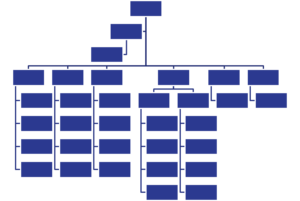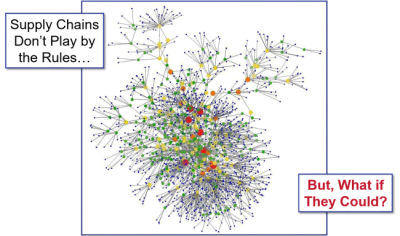This week I spent time in Silicon Valley talking to technology innovators . Disruption in supply chain planning is happening. My angst is that it is not happening faster. We are on a path to reinvent decision-support technologies like supply chain planning. The third act is starting. This will make traditional approaches obsolete. The rate of adoption will be fast for early adopters (next five years), but much slower for conservative followers. The barrier for all is traditional thinking.
. Disruption in supply chain planning is happening. My angst is that it is not happening faster. We are on a path to reinvent decision-support technologies like supply chain planning. The third act is starting. This will make traditional approaches obsolete. The rate of adoption will be fast for early adopters (next five years), but much slower for conservative followers. The barrier for all is traditional thinking.
Let me share a story. Yesterday I visited a company working on cognitive computing. They were very proud of their work in planning with a number of pharmaceutical manufacturers. To tell their story they flashed up a screen of JDA demand planning (which has not changed much since I worked on it in 1995), and proceeded to tell me a story of how their cognitive application improved forecast error (measured by Mean Absolute Percent Error or MAPE) by over 30%. They showed the details by item on improved accuracy. My reaction? Engulfed in sadness.
 Knowing me and my passion for cognitive computing you might ask why. Let me explain. The definition of a demand planning unit in JDA–and other traditional Advanced Planning Solutions–was defined in the 1990s when we were arguing about the possibilities of process improvement with the shift from 32- to 64-bit architectures. These traditional approaches are hierarchical with data viewed in rows and columns The discussions focus on the data; and as a result, teams miss the patterns. The approach is limiting. I think we need to think past rows and columns.
Knowing me and my passion for cognitive computing you might ask why. Let me explain. The definition of a demand planning unit in JDA–and other traditional Advanced Planning Solutions–was defined in the 1990s when we were arguing about the possibilities of process improvement with the shift from 32- to 64-bit architectures. These traditional approaches are hierarchical with data viewed in rows and columns The discussions focus on the data; and as a result, teams miss the patterns. The approach is limiting. I think we need to think past rows and columns.
The systems which we have today stalled in the late 1990’s with the evolution of extended ERP (Advanced Planning Systems bolted to Enterprise Resource Planning in applications like SAP APO and Oracle SCP) and extensive vendor consolidation of best-of-breed providers. Both factors stalled innovation. So my question to the presenter was, “Why waste your time trying to improve a traditional demand planning approach when you could do so much more?” The answer? “We are working with a company that can only take an incremental approach. We must walk before we run.”
The barrier for new technology adoption is us. In this case the client could have defined outside-in processes using IMS and World Health Data to drive/define market-driven, outside-in processes. In the 1990’s channel data was not as available, and memory requirements constrained the processes. Traditional forecasting processes use predictive modeling with order data as an input. Today the order represents three to four months of demand latency. The company could have designed a rules-based ontology to enable concurrent views of attributes, cost, and volume data. The traditional demand planning hierarchy, limited by primary keys on a relational database, yields volume data. As a result, it is difficult to understand the interrelationships of lift and cannibalization.
The translation of demand in traditional advanced planning systems determines safety stock, but there is a greater opportunity for pharmaceutical companies with an inventory turn level of two, and great demand and supply uncertainty, to determine inventory strategies including buffers, push-pull decoupling points, and postponement. We have spent two decades trying to optimize safety stock with little success. The greater value lies in the determination of inventory strategies to drive decisions on form and function of inventory.
 Cognitive computing mines insights based on the interrelationships of contextual data (see the rules-based ontology on the left). As a result we are no longer limited to traditional hierarchical thinking and the visualization is no longer limited to rows and columns. Yet, our brains are hardwired to force traditional demand planning thinking into this more innovative approach.
Cognitive computing mines insights based on the interrelationships of contextual data (see the rules-based ontology on the left). As a result we are no longer limited to traditional hierarchical thinking and the visualization is no longer limited to rows and columns. Yet, our brains are hardwired to force traditional demand planning thinking into this more innovative approach.
True Confession
When I have discussions on demand planning with teams, there are usually a lot of smart guys in the room. Many have large egos. They are often supply chain superheroes. Tradition process definition runs through their veins and they are proud of what they do. They wield large spreadsheets, have deep product knowledge, and reign supreme in the spreadsheet ghettos which are present in most companies.
In the discussion, the first thing you have to do is to set the expectation; that a dialogue on the future of demand planning is not a contest of “who is smartest guy in the room.” Instead, a step-change is needed: a focused effort on redefining the “art of the possible.” Since many of the technologists with the most exciting technologies do not have supply chain backgrounds, it requires an investment of time and energy to “imagine together.”
Why do this? The opportunity is vast.
- Workforce Reduction. I think that we can reduce 80% of planners in global supply chain organizations and drive better answers.
- Better Answers in Less Time. With voice-activated logic we are no longer struggling with the usability of outdated user interfaces. The dirty little secret is that most companies do not use their planning systems. They are just too inflexible.
- Job Satisfaction. The life of a demand planner is tough. Most demand planners feel very little love. They are always wrong and are often the whipping boys when things go wrong.
- Risk Mitigation. The loss of a supply chain superhero today is hard to overcome.
- Less Latency. Organizations that use channel data are in sync with markets. Companies are not today. They are out of step. In most organizations, demand latency of an order has increased over the decade 10X, but supply chain teams do not understand the implications. As a result, the rethinking of planning can reduce costs and drive better outcomes.
New Approaches for Demand Planning
This week, largely by accident, I discussed new approaches to demand planning with five different solution providers. Each is a different, and a novel approach. I welcome innovation in this field. (Traditional approaches did not work very well, and the old-fashioned thinking is even less effective now with globalization.) Over the last decade there was slow progress. We inched along. Adexa drove new thinking in attribute planning, Logility innovated with New Profile Planning, Steelwedge adopted attach rate forecasting approaches, and Terra Technology developed multi-tier demand sensing; but overall, progress was slow, and user satisfaction disappointing. Here are five new approaches I am following (in alpha order):
- E2open. With the purchase of Terra Technology and Orchestro, E2open is experimenting with an approach termed Long-term Demand Sensing (LDS). This product evaluates the market potential of a promotion or a new product launch. Since new products usually have error greater than 70%, and bias with more than 40%, the focus is on understanding baseline lift and market potential. P&G is testing this approach.
- Enterra Solutions. With a history of forecasting military fire in Iraq, Enterra uses cognitive computing capabilities to redefine decision support in consumer products. Their approach is to bundle revenue management, trade promotion, and demand planning together. The pilot results are very promising.
- FusionOps. AI and cognitive computing is entering a hype cycle, and FusionOps wants to lead in a big way. Their focus is on building enterprise class cognitive engines. With a new CEO, and several clients in the pharmaceutical industry, their goal is to dominate the supply chain market in a big way. These are small, but promising pilots.
- Kinaxis. Kinaxis was late to the demand planning market, but I was pleasantly surprised in my briefing this week to see their work on building outside-in processes. The focus is on the use of market/channel data and push the “what-if” analysis through to supply. The work is in beta, but is promising.
- Lokad. Located in Paris, Lokad is modeling probabilistic outcomes in supply chains with extreme error and intermittent demand. This approach is a radical shift from traditional thinking.
As we test new concepts we should continually ask ourselves, “What is the role of demand in the future supply chain?” Today the focus is to improve tactical planning. This includes the purchase of raw materials, defining asset strategies, and translating marketing plans into actionable plans for operations. However, planning horizons are shorter than a decade ago, and these traditional demand planning approaches are not effective in the operational planning horizon to drive replenishment and inventory strategies. Traditional rules-based consumption logic just does not work, and the term ‘demand sensing’ is everywhere, diluting effectiveness in the market. (Many companies claim to sense demand without the capabilities.) Perhaps it is time for a new approach? Especially for supply chains with stark differences–high error and lumpy demand. Hence the blog title, “Different Strokes for Different Folks.”
Next week I will continue the discussion of next-generation planning, with a focus on supply planning and the implications of concurrent planning.
Join Us
Our goal is to help companies take supply chains to the next level. We write for the business visionary. To maximize your learning we offer a number of opportunities.
 Research on Supply Chain Finance. Want to know how others are progressing on cost-to-serve and building supply chain finance organizations? Take our survey, and join a virtual roundtable to discuss the results with others.
Research on Supply Chain Finance. Want to know how others are progressing on cost-to-serve and building supply chain finance organizations? Take our survey, and join a virtual roundtable to discuss the results with others.
Next-Generation Supply Chain Training. Have a number of  high-potential employees you would like to give a leg up on next-generation thinking? The Cross-Company Cohort in May will take a group of leaders through the seven supply chain online learning modules that we built with help from CorpU. There will be European, Asian, and North American cohorts of 30-40 people. Each company can place 1-3 people in a cohort that will run during the period of May-December 2017. If interested, please send an email to Regina Denman at Regina.Denman@supplychaininsights.com.
high-potential employees you would like to give a leg up on next-generation thinking? The Cross-Company Cohort in May will take a group of leaders through the seven supply chain online learning modules that we built with help from CorpU. There will be European, Asian, and North American cohorts of 30-40 people. Each company can place 1-3 people in a cohort that will run during the period of May-December 2017. If interested, please send an email to Regina Denman at Regina.Denman@supplychaininsights.com.
 Network of Networks. Next week several companies will discuss the planned pilots to test blockchain and cognitive learning to improve interoperability across networks. The sessions are open to all innovators. The next formal face-to-face session to discuss the pilots is on April 13 in North America and April 28th in Europe. For an overview of the work, check out this call to action.
Network of Networks. Next week several companies will discuss the planned pilots to test blockchain and cognitive learning to improve interoperability across networks. The sessions are open to all innovators. The next formal face-to-face session to discuss the pilots is on April 13 in North America and April 28th in Europe. For an overview of the work, check out this call to action.
 Imagine. We are finalizing the agenda for the Supply Chain Insights Global Summit. The conference is designed to challenge teams to think different and drive better outcomes. The Summit on September 5-8, 2017 will challenge teams to think out of the box, and is designed to build a guiding coalition between business innovators and technology visionaries.
Imagine. We are finalizing the agenda for the Supply Chain Insights Global Summit. The conference is designed to challenge teams to think different and drive better outcomes. The Summit on September 5-8, 2017 will challenge teams to think out of the box, and is designed to build a guiding coalition between business innovators and technology visionaries.
To register for the events, contact Regina Denman at regina.denman@supplychaininsights.com.







